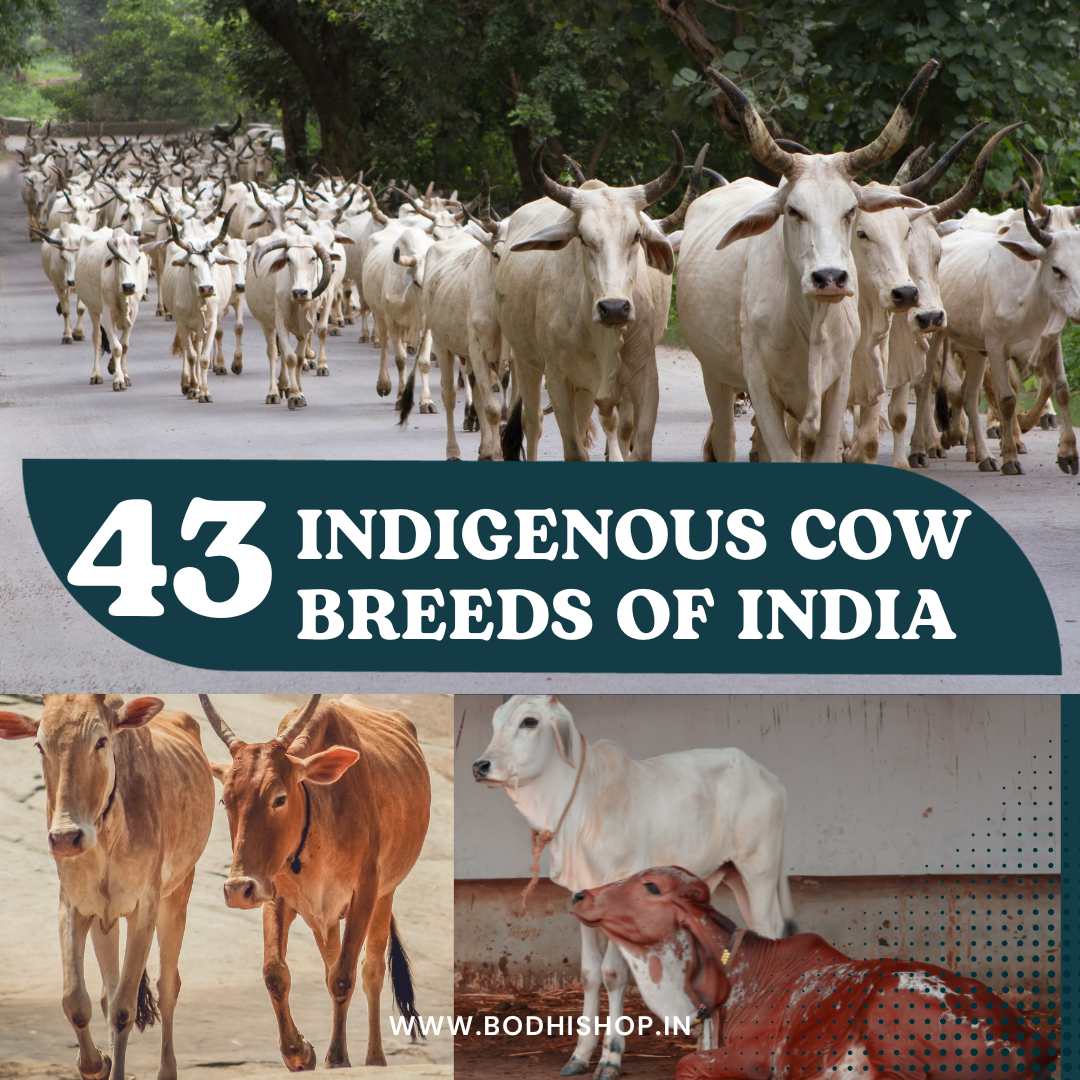
Indigenous Cow Breeds of India - Popular and Rare ones
Share
India is home to a diverse range of indigenous cattle breeds, each adapted to specific local environments and serving various purposes such as milk production, agricultural work, and religious ceremonies.
Here are some notable indigenous cow breeds in India:
-
Gir: Originating from the Gir forest region in Gujarat, the Gir breed is known for its high milk yield and robustness. They have a distinctive hump and are often used in crossbreeding programs to improve milk production in other breeds.
-
Sahiwal: Named after the Sahiwal district in Punjab, this breed is well-adapted to the tropical climate of the Indian subcontinent. Sahiwals are valued for their high milk yield, heat tolerance, and resistance to diseases.
-
Red Sindhi: Hailing from the Sindh region, now in Pakistan, Red Sindhi cattle are known for their adaptability to hot climates and resistance to various diseases. They are primarily raised for dairy purposes.
-
Tharparkar: This breed is native to the Thar Desert in Rajasthan and is well-suited to arid conditions. Tharparkar cattle are multipurpose, providing both milk and draught power.
-
Deoni: Originating from the Deoni region in Maharashtra and Karnataka, Deoni cattle are dual-purpose breeds, known for both milk and draught capabilities. They are usually gray or white with dark markings.
-
Hallikar: Native to Karnataka, Hallikar cattle are renowned for their strength and endurance, making them suitable for agricultural work. They are primarily used as draught animals.
-
Kankrej: This breed is found in the Kankrej region of Gujarat and is known for its adaptability to harsh environmental conditions. Kankrej cattle are used for both milk and draught purposes.
-
Ongole: Also known as Nellore, the Ongole breed is native to Andhra Pradesh. Known for its distinctive hump and white or light gray coat, Ongole cattle are used in agriculture and are resistant to diseases.
- Vechur: The Vechur breed, found in Kerala, is one of the smallest cattle breeds in the world. Known for its small size and high-fat content in milk, Vechur cows are critically endangered.
These indigenous cattle breeds play a crucial role in the agricultural and cultural landscape of India. Efforts are being made to conserve and promote these breeds to ensure their sustainability and preserve the genetic diversity they offer.
Which are the other cow breeds in India?
There are 43 registered Desi Cow breeds in India by the NBAGR. Here is the complete list.
| Breed of Cow | Native | |
| 1 | Amritmahal | Karnataka |
| 2 | Bachaur | Bihar |
| 3 | Bargur | Tamilnadu |
| 4 | Dangi | Maharashtra and Madhya Pradesh |
| 5 | Deoni | Maharashtra and Karnataka |
| 6 | Gaolao | Maharashtra and Madhya Pradesh |
| 7 | Gir | Gujrat |
| 8 | Hallikar | Karnataka |
| 9 | Hariana | Haryana, Uttar Pradesh and Rajasthan |
| 10 | Kangayam | Tamilnadu |
| 11 | Kankrej | Gujarat and Rajasthan |
| 12 | Kenkatha | Uttar Pradesh and Madhya Pradesh |
| 13 | Kherigarh | Uttar Pradesh |
| 14 | Khillar | Maharashtra and Karnataka |
| 15 | Krishna Valley | Karnataka |
| 16 | Malvi | Madhya Pradesh |
| 17 | Mewati | Rajasthan, Haryana and Uttar Pradesh |
| 18 | Nagori | Rajasthan |
| 19 | Nimari | Madhya Pradesh |
| 20 | Ongole | Andhra Pradesh |
| 21 | Ponwar | Uttar Pradesh |
| 22 | Punganur | Andhra Pradesh |
| 23 | Rathi | Rajasthan |
| 24 | Red Kandhari | Maharashtra |
| 25 | Red Sindhi | On organized farms only |
| 26 | Sahiwal | Punjab and Rajasthan |
| 27 | Siri | Sikkim and West Bengal |
| 28 | Tharparkar | Rajasthan |
| 29 | Umblachery | Tamilnadu |
| 30 | Vechur | Kerala |
| 31 | Motu | Orissa,Chhattisgarh and Andhra Pradesh |
| 32 | Ghumusari | Orissa |
| 33 | Binjharpuri | Orissa |
| 34 | Khariar | Orissa |
| 35 | Pulikulam | Tamilnadu |
| 36 | Kosali | Chhattisgarh |
| 37 | Malnad Gidda | Karnataka |
| 38 | Belahi | Haryana and Chandigarh |
| 39 | Gangatiri | Uttar Pradesh and Bihar |
| 40 | Badri | Uttarakhand |
| 41 | Lakhimi | Assam |
| 42 | Ladakhi | Jammu and Kashmir |
| 43 | Konkan Kapila | Maharashtra and Goa |
What is the difference between Bos Indicus and Bos Taurus cows?
The terms "Bos indicus" and "Bos taurus" refer to two major categories or species of cattle, each with distinct characteristics. These classifications are based on the geographical and evolutionary origins of the cattle. Cows that are native to India since ancient times are of Bos Indicus origin. Here are the key differences between Bos indicus and Bos taurus:
Bos indicus:
-
Geographical Origin: Bos indicus cattle are native to the Indian subcontinent and surrounding regions, including Southeast Asia and parts of Africa.
-
Physical Characteristics:
- Prominent Hump: One of the most noticeable features is the presence of a well-developed hump over the shoulders, which contains a large amount of muscle.
- Loose Skin: Bos indicus cattle often have loose, droopy skin, which helps them in regulating body temperature in hot climates.
- Large Ears: They typically have large, pendulous ears, which also aid in heat dissipation.
- Resistance to Heat: Bos indicus cattle are well-adapted to hot and tropical climates, showing resilience to high temperatures and resistance to certain diseases prevalent in those regions.
-
Behavioral Traits:
- Heat Tolerance: Bos indicus cattle are better suited to hot and humid environments, displaying higher tolerance to heat stress compared to Bos taurus breeds.
- Grazing Habits: They often exhibit grazing behavior and are well-adapted to foraging in diverse and sometimes challenging landscapes.
- Loving & Caring: Generally they exhibit extremely docile, loving & caring nature and have been considered as a part of a farmer's family since ancient India.
Bos taurus:
-
Geographical Origin: Bos taurus cattle are native to Europe, including breeds from Britain, France, and the Iberian Peninsula.
-
Physical Characteristics:
- Absence of Prominent Hump: Unlike Bos indicus, Bos taurus cattle generally lack a well-defined hump over the shoulders.
- Tighter Skin: Bos taurus cattle usually have tighter skin compared to the loose skin of Bos indicus breeds.
- Smaller Ears: They tend to have smaller, upright ears compared to the larger, droopy ears of Bos indicus cattle.
- Varied Coat Colors: Bos taurus breeds exhibit a wide range of coat colors and patterns.
-
Behavioral Traits:
- Cold Tolerance: Bos taurus cattle are better adapted to cooler climates and may struggle significantly in extremely hot conditions.
- Milk Production: Many Bos taurus breeds are known for high milk production, and they have been selectively bred for various purposes, including dairy farming.
It's important to note that these distinctions are generalizations, and there is considerable diversity within each category.
Why people from 18+ countries trust Bodhishop.in?
Since 2018, Bodhishop.in has facilitated the shipment of indigenous desi cow milk products and traditional Indian cowdung-based agro products to more than 18 countries. The platform's stringent verification and onboarding procedures play a crucial role in building customer confidence, ensuring that they receive products that are 100% pure, authentic, traditional, and cruelty-free. This commitment has contributed to Bodhishop.in becoming a trusted source for a global audience.
This article is a property of Bodhishop.in Any unauthorized duplication, reproduction or publication is strictly prohibited. Contact support@bodhishop.in for licensing of the above article.
